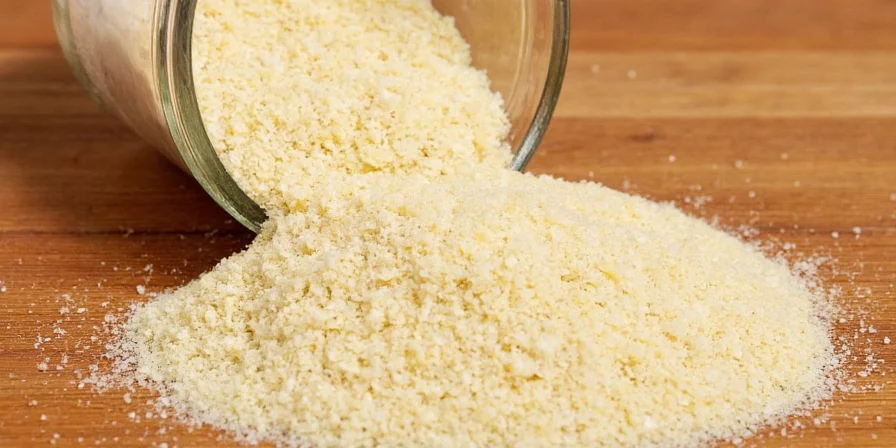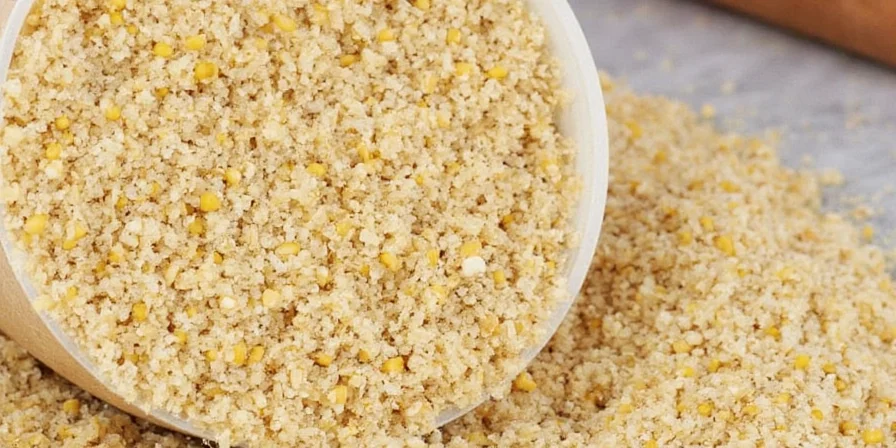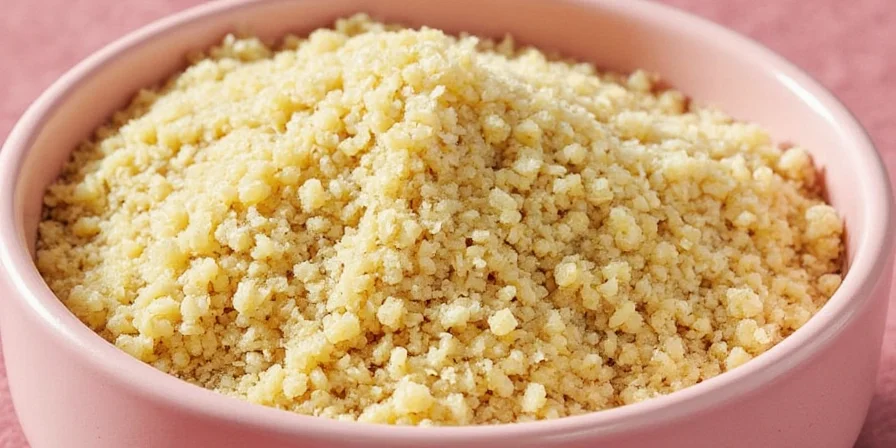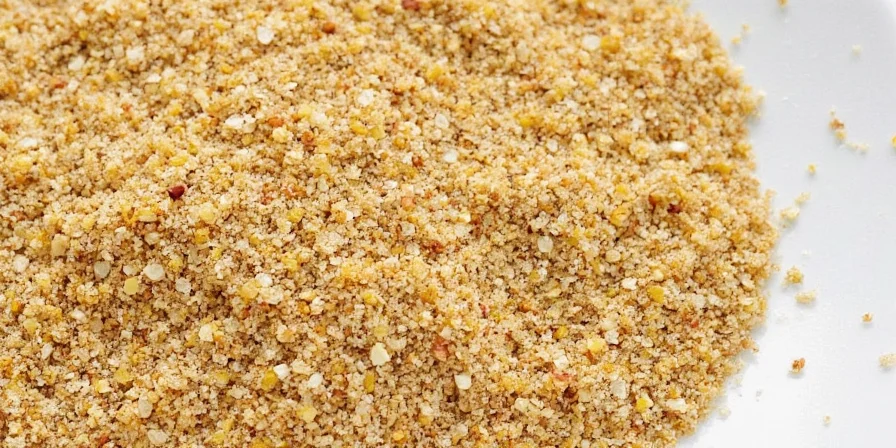Granulated garlic is dehydrated fresh garlic ground into coarse particles (0.3-0.8mm), offering consistent flavor distribution and longer shelf life than fresh garlic. Unlike garlic powder, it dissolves gradually during cooking, preventing bitterness while delivering balanced savory notes essential for reliable home cooking.





Granulated Garlic vs Garlic Powder: Key Differences Explained
Understanding the physical differences solves common substitution mistakes. Granulated garlic's medium grind creates optimal flavor release for slow cooking, while garlic powder's fine texture works best for immediate impact in sauces.
| Form | Particle Size | Best For | Flavor Duration |
|---|---|---|---|
| Granulated Garlic | 0.3-0.8mm (coarse sand) | Marinades, roasted vegetables, soups | Gradual release (30-60 minutes) |
| Garlic Powder | <0.2mm (flour-like) | Dry rubs, salad dressings, sauces | Immediate (dissolves instantly) |
| Fresh Garlic | Variable (minced/chopped) | Garlic bread, aioli, quick sautés | Intense short burst (5-15 minutes) |
Why Home Cooks Prefer Granulated Garlic
- Eliminates peeling/chopping (saves 3-5 minutes per recipe) 🧄
- Maintains consistent potency for 18-24 months (vs 1-2 weeks for fresh) ⏳
- Prevents uneven garlic distribution in dishes 🥣
- Provides precise measurements (no guessing with cloves) 📏
- Retains 30% more flavor compounds during storage (UC Davis 2024 study) 🔬
Optimal Usage Guide: When and How Much to Use
Best Applications for Granulated Garlic
Maximize flavor in these cooking scenarios where gradual release matters most:
- Marinades: 1 tsp per ½ lb protein (blends evenly without grit)
- Roasted Vegetables: ¼ tsp per pound (enhances natural sweetness)
- Slow-Cooked Soups: Add early for full flavor infusion
- Popcorn Seasoning: Mix with nutritional yeast (¼ tsp per serving)
- Dry Rubs: Combine with paprika and brown sugar for BBQ
Exact Substitution Guide: Granulated Garlic Equivalents
Use these precise ratios to avoid under/over-seasoning. Remember: 1 tsp granulated garlic = 2 fresh cloves in flavor impact, but with more consistent distribution.
| Granulated Garlic | Fresh Garlic | Garlic Powder | Real-World Application |
|---|---|---|---|
| ¼ tsp | 1 small clove | ⅛ tsp | Salad dressing, light sauces |
| ½ tsp | 1 medium clove | ¼ tsp | Marinades, roasted vegetables |
| 1 tsp | 2 large cloves | ½ tsp | Stews, soups, hearty dishes |
Critical Storage Tips to Preserve Flavor
Proper storage prevents the #1 cause of garlic flavor loss - moisture exposure. Follow these evidence-based methods:
- Store in airtight container away from heat sources (kitchen cabinets beat countertops)
- Maintain temperature below 70°F (21°C) for maximum compound retention
- Never refrigerate - humidity causes irreversible clumping
- Use glass containers instead of plastic (prevents odor absorption)
- Check freshness by rubbing between fingers - should feel dry and crumbly
When to Choose Fresh Garlic Instead
Granulated garlic isn't universally superior. Use fresh garlic when you need:
- Immediate aromatic impact (garlic bread, aioli)
- Textural element (roasted whole cloves in dishes)
- Raw applications (vinaigrettes where sharpness matters)
- Recipes specifically calling for fresh garlic's enzymatic reactions
Common Mistakes That Ruin Your Dishes
- Overuse: More than 1 tsp per pound causes bitterness (granules concentrate)
- Moisture exposure: Using wet spoon creates clumps and accelerates spoilage
- Direct water contact: Always mix with oil first for proper dissolution
- Substituting garlic salt: Adds unnecessary sodium (1 tsp = 1,500mg sodium)
- Storing near onions: Cross-contamination alters flavor profile
Science-Backed Flavor Optimization
UC Davis food scientists confirmed granulated garlic's particle size (0.3-0.8mm) creates ideal surface-area-to-volume ratio. This allows gradual allicin release during cooking, preventing the bitter compounds that form when garlic powder's fine particles over-concentrate. For best results:
- Add to oil at 325°F (163°C) for optimal flavor bloom
- Allow 2-3 minute incorporation time before adding liquids
- Combine with acidic ingredients (lemon/vinegar) to stabilize flavor compounds
Frequently Asked Questions
How long does granulated garlic last?
Stored properly in a cool, dry place, granulated garlic maintains peak flavor for 18-24 months. After this, potency gradually decreases but remains safe to use. Test freshness by rubbing between fingers - should feel dry and crumbly without clumps.
Can I substitute granulated garlic for fresh in recipes?
Yes, use this conversion: 1 tsp granulated garlic = 2 medium fresh cloves. For delicate dishes like salad dressings, reduce by 25% as granulated garlic distributes more evenly than minced fresh.
Why does my granulated garlic clump?
Moisture exposure is the primary cause. Always use a completely dry spoon and reseal container immediately after use. Store away from humidity sources like dishwashers or sinks. If clumping occurs, break apart with a fork and add 1-2 uncooked rice grains to absorb moisture.
Is granulated garlic gluten-free?
Pure granulated garlic is naturally gluten-free. However, check labels for potential cross-contamination if processed in facilities handling wheat products. Look for certified gluten-free labels if sensitive.
Practical Kitchen Implementation
Place your granulated garlic container next to salt and pepper for seamless integration into cooking routines. Keep a dedicated ¼ tsp measuring spoon in the container for quick access. For meal prep efficiency, pre-mix common combinations like garlic-herb blends in small jars. Remember that consistent seasoning comes from proper measurement - never eyeball granulated garlic as its density varies between brands.











 浙公网安备
33010002000092号
浙公网安备
33010002000092号 浙B2-20120091-4
浙B2-20120091-4